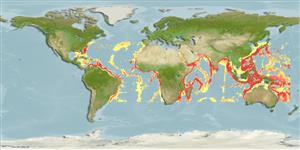Common names from other countries
Teleostei (teleosts) >
Pleuronectiformes (Flatfishes) >
Bothidae (Lefteye flounders)
Etymology: Chascanopsetta: Greek, chaskanon, -ou = a mask used in classicla Greek theatre with the mouth opened + Greek, psetta = grouper (Ref. 45335).
More on author: Alcock.
Environment: milieu / climate zone / depth range / distribution range
Ecology
Marine; bathydemersal; depth range 60 - 3210 m (Ref. 58018). Deep-water; 40°N - 32°S, 90°W - 168°E
Circumglobal: tropical; from the Western Atlantic to Western Pacific.
Size / Weight / Age
Maturity: Lm ? range ? - ? cm
Max length : 40.0 cm TL male/unsexed; (Ref. 30573); common length : 25.0 cm TL male/unsexed; (Ref. 30573)
Dorsal spines (total): 0; Dorsal soft rays (total): 111 - 127; Anal spines: 0; Anal soft rays: 76 - 88. Body flexible. Mouth extremely large, maxillary not projecting beyond tip of snout. No canine tooth. Tip of lower jaw slightly beyond the upper; upper jaw shorter than head length.
Inhabits the deeper continental shelf to depths of almost 1,000 m (Ref. 27121). Found on sand, mud and clay bottoms (Ref. 4417). Feeds on larger benthic animals (Ref. 30573). Minimum depth reported taken from Ref. 30573.
Life cycle and mating behavior
Maturities | Reproduction | Spawnings | Egg(s) | Fecundities | Larvae
Hensley, D.A., 1986. Bothidae. p. 854-863. In M.M. Smith and P.C. Heemstra (eds.) Smiths' sea fishes. Springer-Verlag, Berlin. (Ref. 4417)
IUCN Red List Status (Ref. 130435)
CITES (Ref. 128078)
Not Evaluated
Threat to humans
Harmless
Human uses
Fisheries: commercial
Tools
Special reports
Download XML
Internet sources
Estimates based on models
Preferred temperature (Ref.
115969): 3.6 - 10.5, mean 5.7 (based on 1475 cells).
Phylogenetic diversity index (Ref.
82804): PD
50 = 0.5039 [Uniqueness, from 0.5 = low to 2.0 = high].
Bayesian length-weight: a=0.00912 (0.00408 - 0.02036), b=3.05 (2.87 - 3.23), in cm Total Length, based on LWR estimates for this (Sub)family-body shape (Ref.
93245).
Trophic level (Ref.
69278): 3.5 ±0.37 se; based on food items.
Resilience (Ref.
120179): Low, minimum population doubling time 4.5 - 14 years (Preliminary K or Fecundity.).
Fishing Vulnerability (Ref.
59153): Low to moderate vulnerability (30 of 100).
